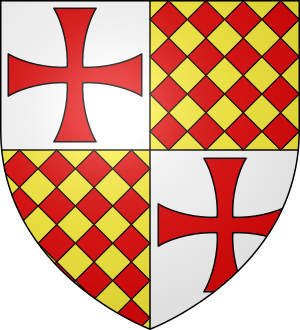Robert de Craon facts for kids
Quick facts for kids
Robert de Craon
|
|
|---|---|

Coat of arms of Robert de Craon
|
|
| 2nd Grand Master of the Knights Templar | |
| In office 1136–1149 |
|
| Preceded by | Hugues de Payens |
| Succeeded by | Everard des Barres |
| Personal details | |
| Born | Unknown |
| Died | 13 January 1149 |
| Nationality | French |
| Military service | |
| Allegiance | |
| Battles/wars | Second Crusade |
Robert de Craon or Robert Burgundio was a very important leader of the Knights Templar. He was the second Grand Master of this famous group, leading them from 1136 until he passed away in 1149. Robert helped the Templars become officially recognized by the Pope. This made them very powerful and independent from other church or government leaders. He also helped the Order grow by gaining new castles and land in Spain.
Life of Robert de Craon
Robert de Craon was the son of Renaud le Bourguignon and Ennoguen de Vitré. He was going to get married to the daughter of a lord from Angoumois. However, he decided not to marry and instead traveled to Palestine. He did this after learning about the Knights Templar Order. This group had just been started by Hugues de Payens.
Becoming Grand Master
Robert quickly showed he was a brave soldier and a very religious person. In 1136, the first Grand Master, Hugues de Payens, died. Robert de Craon was then chosen to be the new Grand Master. He was very good at organizing things and making rules. He helped turn the Templar Order into a strong and important force in the Crusader states. These were Christian states set up in the Middle East.
Important Achievements
On March 29, 1139, Pope Innocent II issued an important document called a papal bull. This bull was named Omne Datum Optimum. It said that the Templars did not have to pay tithes (a type of tax to the church). It also made them independent from the control of any church leaders. The Templars were also given a special uniform. They could wear a red cross over a white tunic (a long shirt).
In 1143, Robert worked with Ramon Berenguer IV, Count of Barcelona. They arranged for six castles and their surrounding areas to be given to the Templars. These castles were Monzon, Mongay, Chalamera, Barbara, Belchite, and Remolins in Spain. This helped the Templar Order expand its power.
Later Life and Death
Robert de Craon took part in the Council of Acre on June 24, 1148. This meeting happened during the Second Crusade. The Crusades were a series of religious wars. Robert de Craon died on January 13, 1149. After his death, Everard des Barres became the next Grand Master in April of that year.
| Religious titles | ||
|---|---|---|
| Preceded by Hugues de Payens |
Grand Master of the Knights Templar 1136–1147 |
Succeeded by Everard des Barres |

